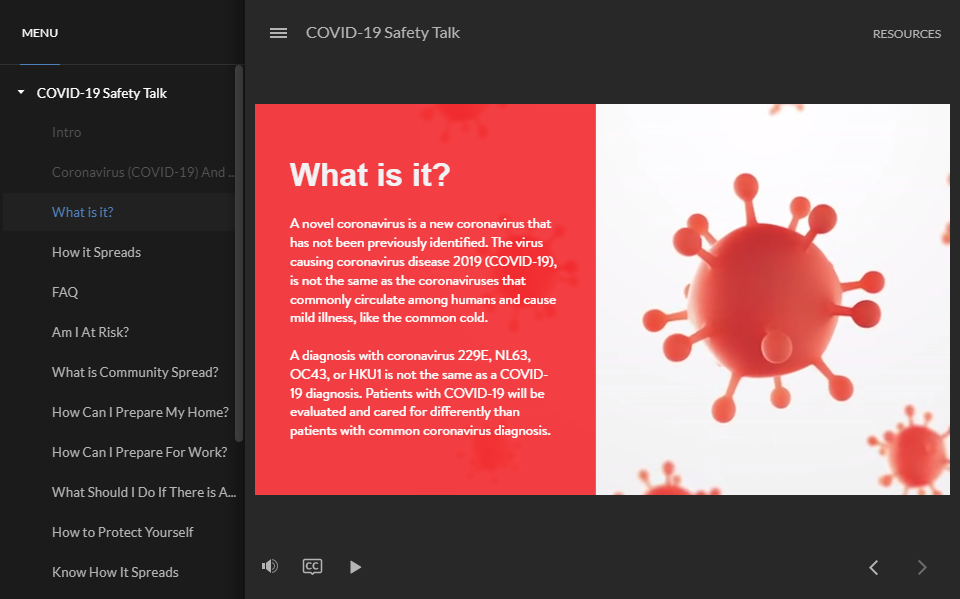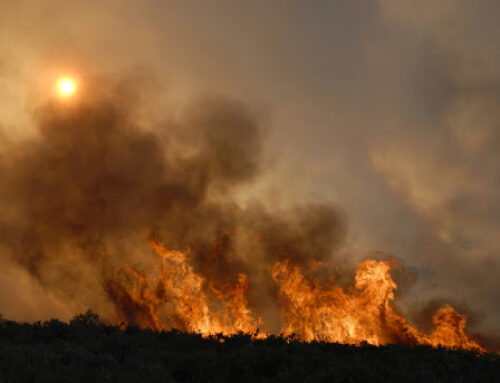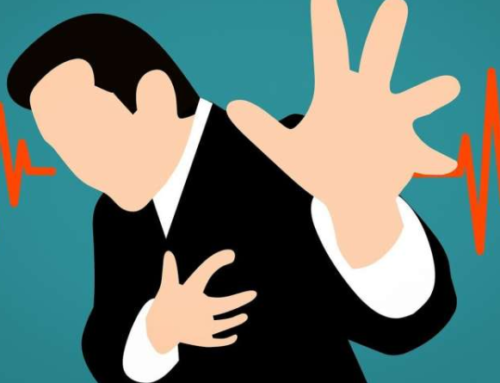Download Instructor-Led Material
Meeting Kit |
PowerPoint |
Safety Talk
WHAT’S AT STAKE?
According to the WHO, coronaviruses are a large family of viruses that range from the common cold to much more serious diseases. These diseases can infect both humans and animals. The strain that began spreading in Wuhan, the capital of China’s Hubei province, is related to two other coronaviruses that have caused major outbreaks in recent years: severe acute respiratory syndrome (SARS) and Middle East respiratory syndrome (MERS).
WHAT’S THE DANGER?
Symptoms of a coronavirus infection range in severity from respiratory problems to cases of pneumonia, kidney failure and a buildup of fluid in the lungs.
Epidemiologists are still trying to determine exactly how deadly COVID-19 is.
About 2% of reported cases have been fatal, but many experts say the death rate could be lower. That’s because early in an outbreak, mild illnesses may not be reported. If only people with severe illness — who are more likely to die — seek care, the virus will appear much more deadly than it really is because of all the uncounted people with milder symptoms.
Early in the outbreak, one expert estimated that although 2,000 cases had been reported, 100,000 people probably were sick. Under counting cases can artificially increase the infection’s mortality rate.
COVID-19 spreads more easily than SARS and is similar to other coronaviruses that cause cold-like symptoms, experts have said. It appears to be highly transmissible, and since cases are mild, the disease may be more widespread than current testing numbers suggest. There have been reports of people transmitting the virus before they show symptoms, but most experts think this is probably not a major driver of new infections. What is concerning, however, is that symptoms can be mild, and the disease can clearly spread before people realize they’re sick. SARS spread when people had full-blown illness, which is one reason it was possible to contain it — it was easier to tell who had the virus.
A report in the New England Journal of Medicine suggested COVID-19 reaches peak infectiousness shortly after people start to feel sick, spreading in the manner of the flu. A study published in JAMA chronicled the case of a 20-year-old Wuhan woman who appeared to infect five relatives, even though she never showed signs of illness.
HOW TO PROTECT YOURSELF
Recognize the Symptoms
According to the WHO, signs of infection include fever, cough, shortness of breath and breathing difficulties. In more severe cases, it can lead to pneumonia, multiple organ failure and even death.
Current estimates of the incubation period – the amount of time between infection and the onset of symptoms – range from one to 14 days. Most infected people show symptoms within five to six days. However, infected patients can also be asymptomatic, meaning they do not display any symptoms despite having the virus in their systems.
Who Is At Risk?
- Those with weakened immune systems, the elderly, and very young children are at greater risk.
- Healthcare providers and other professions with greater risk of exposure are more at risk.
- Those traveling to areas deemed of greater exposure risk.
How Should You Prepare?
Epidemiology experts said the most important aspect of preparedness costs nothing at all — calm.
There are some basic precautions you can take, which are the same as what you should be doing every day to stave off other respiratory diseases. You’ve seen the guidance before: Wash your hands regularly. Cover your nose and mouth when you sneeze. And when you’re sick, stay home from work or school and drink lots of fluids.
The CDC recommends washing with soap and water for at least 20 seconds after using the bathroom, before eating and after blowing your nose or sneezing. It also advises not to touch your eyes, nose and mouth and to clean objects and surfaces you touch often.
Misconceptions & FAQs
Does spraying your body with alcohol or chlorine kill the virus? Doctors say don’t try it. Aside from it potentially hurting you, it won’t kill viruses that have already entered your body.
Can pets potentially spread the new coronavirus? The WHO says there is no evidence that cats or dogs can be infected, or spread the virus that causes COVID-19.
Do flu or pneumonia vaccines protect you from getting this strain of coronavirus? No. The flu vaccine is meant to protect you against influenza A and influenza B, and the pneumonia vaccine is to protect you against bacterial pneumonia. The pneumonia that is caused from COVID-19 is a viral pneumonia, there’s no cure for that. The only treatment for that right now is supportive care, fluids, oxygen, Tylenol, ibuprofen — that sort of thing.
Do we need to prepare for a possible pandemic (buying canned goods, supplies etc.)? It’s always a good idea to have some water, some canned foods in case of any emergency, whether it’s a hurricane or a tornado or a viral pandemic. You don’t have to go out and spend $1,000 on groceries, but it’s not a bad idea to have a supply at your home for safety purposes … It’s also very important to make sure you have a proper amount of medications and make sure they’re stored properly as well.
How contagious is this strain of coronavirus? This strain of the coronavirus, COVID-19, seems to be highly infectious, highly contagious, and is usually spread if someone is coughing and sneezing, and those particles get into your lungs, into your eyes, into your nose and into your mouth. That’s why it’s so important if you’re coughing and sneezing, cough into your elbow. If you’re sick — stay home. Don’t go work if you’re sick, don’t travel if you’re sick and take common sense precautions.
Are facemasks necessary? Facemasks are only necessary if you’re a doctor, if you’re a nurse, if you’re working in a hospital, if you’re a health care provider taking care of someone that might have a virus that’s highly transmissable. If you’re walking down the street, if you’re not in the medical field, no, you don’t need to wear a mask. It really is not going to protect you against the coronavirus, or any other virus … they’re microscopic, they can penetrate through masks.
What If I Have COVID-19?
Stay home except to get medical care People who are mildly ill with COVID-19 are able to isolate at home during their illness. You should restrict activities outside your home, except for getting medical care. Do not go to work, school, or public areas. Avoid using public transportation, ride-sharing, or taxis.
Separate yourself from other people and animals in your home People: As much as possible, you should stay in a specific room and away from other people in your home. Also, you should use a separate bathroom, if available.
Animals: You should restrict contact with pets and other animals while you are sick with COVID-19, just like you would around other people. Although there have not been reports of pets or other animals becoming sick with COVID-19, it is still recommended that people sick with COVID-19 limit contact with animals until more information is known about the virus. When possible, have another member of your household care for your animals while you are sick. If you are sick with COVID-19, avoid contact with your pet, including petting, snuggling, being kissed or licked, and sharing food. If you must care for your pet or be around animals while you are sick, wash your hands before and after you interact with pets and wear a facemask.
Call ahead before visiting your doctor If you have a medical appointment, call the healthcare provider and tell them that you have or may have COVID-19. This will help the healthcare provider’s office take steps to keep other people from getting infected or exposed.
Wear a facemask You should wear a facemask when you are around other people (e.g., sharing a room or vehicle) or pets and before you enter a healthcare provider’s office. If you are not able to wear a facemask (for example, because it causes trouble breathing), then people who live with you should not stay in the same room with you, or they should wear a facemask if they enter your room.
Cover your coughs and sneezes Cover your mouth and nose with a tissue when you cough or sneeze. Throw used tissues in a lined trash can. Immediately wash your hands with soap and water for at least 20 seconds or, if soap and water are not available, clean your hands with an alcohol-based hand sanitizer that contains at least 60% alcohol.
Clean your hands often Wash your hands often with soap and water for at least 20 seconds, especially after blowing your nose, coughing, or sneezing; going to the bathroom; and before eating or preparing food. If soap and water are not readily available, use an alcohol-based hand sanitizer with at least 60% alcohol, covering all surfaces of your hands and rubbing them together until they feel dry.
Soap and water are the best option if hands are visibly dirty. Avoid touching your eyes, nose, and mouth with unwashed hands.
Avoid sharing personal household items. You should not share dishes, drinking glasses, cups, eating utensils, towels, or bedding with other people or pets in your home. After using these items, they should be washed thoroughly with soap and water.
Clean all “high-touch” surfaces everyday High touch surfaces include counters, tabletops, doorknobs, bathroom fixtures, toilets, phones, keyboards, tablets, and bedside tables. Also, clean any surfaces that may have blood, stool, or body fluids on them. Use a household cleaning spray or wipe, according to the label instructions. Labels contain instructions for safe and effective use of the cleaning product including precautions you should take when applying the product, such as wearing gloves and making sure you have good ventilation during use of the product.
Monitor your symptoms Seek prompt medical attention if your illness is worsening (e.g., difficulty breathing). Before seeking care, call your healthcare provider and tell them that you have, or are being evaluated for, COVID-19. Put on a facemask before you enter the facility. These steps will help the healthcare provider’s office to keep other people in the office or waiting room from getting infected or exposed. Ask your healthcare provider to call the local or state health department. Persons who are placed under active monitoring or facilitated self-monitoring should follow instructions provided by their local health department or occupational health professionals, as appropriate.
If you have a medical emergency and need to call 911, notify the dispatch personnel that you have, or are being evaluated for COVID-19. If possible, put on a facemask before emergency medical services arrive.
Discontinuing home isolation Patients with confirmed COVID-19 should remain under home isolation precautions until the risk of secondary transmission to others is thought to be low. The decision to discontinue home isolation precautions should be made on a case-by-case basis, in consultation with healthcare providers and state and local health departments.
Source: https://www.cdc.gov/coronavirus/2019-ncov/about/steps-when-sick.html
FINAL WORD
Infectious diseases, although not typically as widespread as COVID-19, are frightening things. Knowing what it is, how to protect yourself and how to stop the spread is important to keep you, your co-workers and your family safe and healthy.







